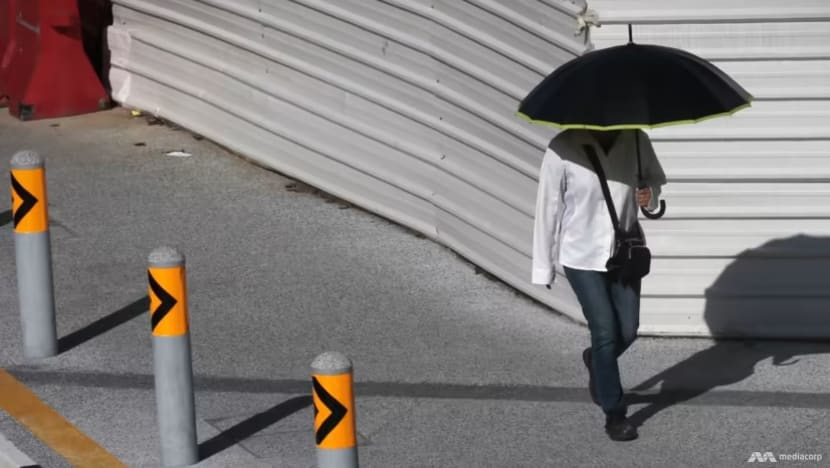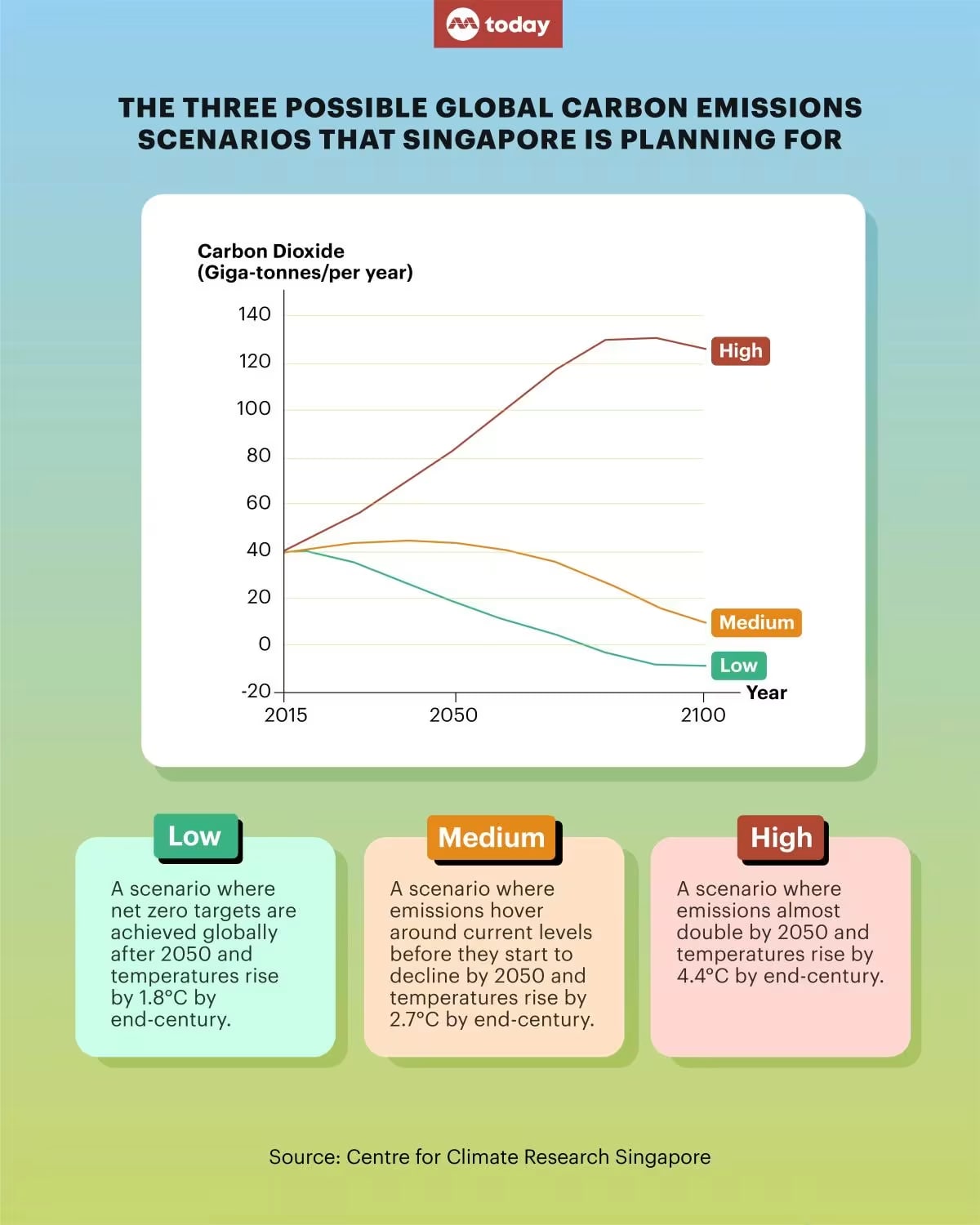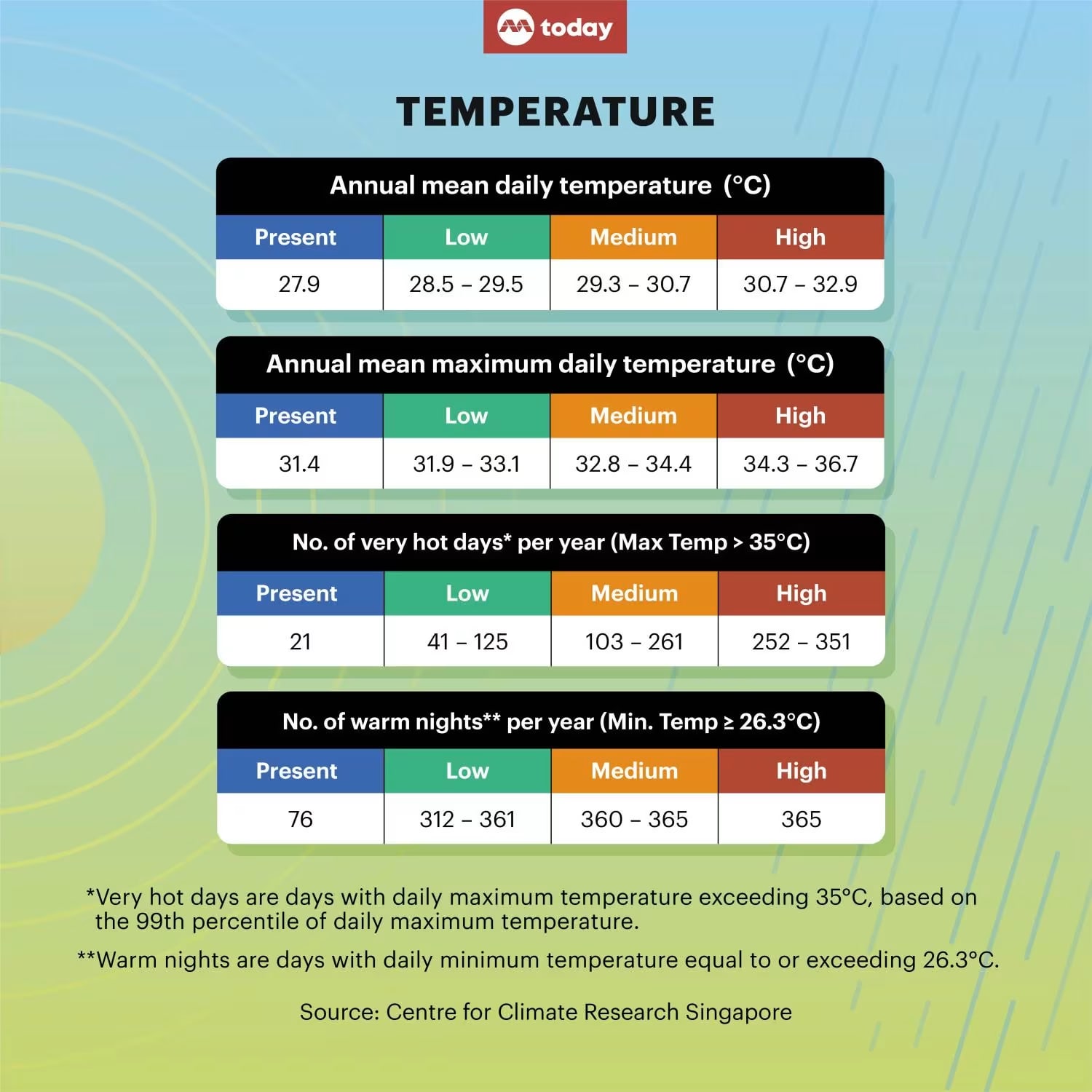Days hotter than 35°C almost all year round within this century: 5 key takeaways from Singapore's new climate study

A person carrying an umbrella on a sunny day. (File photo: TODAY)

This audio is generated by an AI tool.
- By 2100, Singapore could possibly face very hot days, where daily maximum temperatures exceed 35 degrees Celsius, for up to 351 days in a year
- It could also experience longer and more frequent dry spells and intense rainfalls
- These were among the latest climate projections mapped out by the Centre for Climate Research Singapore, in a report published on Friday (Jan 5)
- The projections will be used to help the Government plan how to protect Singapore from the effects of climate change
SINGAPORE: By the end of the century, Singapore could possibly face very hot days of temperatures exceeding 35 degrees Celsius for up to 351 days in a year.
Singapore could also suffer from more frequent and longer-lasting dry spells.
These are a couple of the latest projected climate scenarios mapped out by the Centre for Climate Research Singapore (CCRS), which issued a report on Friday (Jan 5) on the findings from its third national climate change study, also known as V3.
The centre, which sits under the National Environment Agency’s Meteorological Service Singapore, last issued projections in 2015, in its V2 report.
Compared to the V2, the V3 is based on expanded and improved data sets, and so gives a more accurate simulation of the regional climate, the CCRS said in a media release on Friday.

Here are five key takeaways from the report:
WEATHER EXTREMES WILL BECOME THE NORM
The V3 forecasts an intensification of weather phenomena across all climate metrics by the end of the century, including mean sea level, mean daily temperature, number of “very hot” days exceeding 35 degrees Celsius, warm nights, and annual average rainfall.
In the worst case scenario, by 2100 Singapore could eventually have only 14 days a year where the mercury drops below 35 degrees Celsius, the V3 projects.
The outlook is also rather dire in the nearer future: By mid-century, Singapore could experience between 47 and 189 “very hot” days, more than double the current average of 21 such days annually.
By 2050, average daily mean temperatures could also increase by between 0.6 degrees Celsius and 2.2 degrees Celsius, depending on whether the world can cut carbon emissions or continues to burn ever more fossil fuels.
This would bring mid-century temperatures up to between 28.5 degrees Celsius and 30.1 degrees Celsius, from the current mean of 27.9 degrees Celsius.
By the end of the century, average daily mean temperatures could increase by between 0.6 degrees Celsius and 5 degrees Celsius, the study predicts. This means that by 2100 Singapore’s future average daily mean temperature will be between 28.5 degrees Celsius and 32.9 degrees Celsius, up from its current mean of 27.9 degrees Celsius.

Historically dry seasons in the year could become even drier, while extreme daily rainfall is projected to increase across all seasons and scenarios, for example by about 6 to 92 per cent in the inter-monsoon months of April and May.
Meanwhile, seasonal rainfall in the dry months of June, July and August could fall significantly below the historical low of 314mm, recorded in 1997, around once every three years, by 2100.
The study also projected that mean sea levels could rise by between 0.23m and 1.15m by 2100 and by up to around 2m by 2150, depending on whether and by how much the world can reduce carbon emissions.
In the worst case scenario, wind speeds could increase by up to 20 per cent during the monsoon seasons, and by up to 11 per cent in the inter-monsoon months of April and May.
LATEST STUDY OFFERS A MORE DETAILED LOOK THAN PAST REPORTS
A refresh of its predecessor, the V3 study offers a more granular look at Singapore and Southeast Asia’s projected climate in the century ahead by downscaling global models and predictions for temperatures, rainfall, wind speeds and sea levels.
The climate change projections done by the Intergovernmental Panel on Climate Change (IPCC) typically offer a more big-picture look at global and large-scale climate change.
These projections lack the granularity necessary for assessing climate change at the regional and local level to guide national planning.
To bridge this gap, the V3 study downscaled a selected set of global climate models from the IPCC’s reports to a more concentrated area – of 8km over Southeast Asia and 2km over Singapore – to provide more granular and focused projections.
THE SINGAPORE GOVERNMENT IS PLANNING FOR THE WORST
“The government will take into account the range of possible climate outcomes, including the high emissions pathway, in Singapore’s adaptation plans to ensure that we remain climate resilient,” the CCRS said in a statement on Friday accompanying the V3 report.
The “high emissions pathway” refers to a scenario driven by the continuation of energy-intensive, fossil fuel-based development across the world.
The Singapore government has already announced several long-term plans and initiatives to shield Singapore from the most extreme effects of climate change, such as the development of Long Island to protect the coastlines and guard against rising sea levels.
Based on the findings of the V3, the government would also review Singapore’s building codes and the structural integrity of its infrastructure, to ensure that buildings on the island can withstand the projected changes in the climate, such as higher temperatures and increased wind speeds.
INDIVIDUALS CAN PLAY A PART
Government action alone would not be enough to combat the effects of climate change, the CCRS said, adding that everyone, including consumers and businesses, has a role to play.
Individuals could raise their air-conditioner temperature by 1 degree Celsius or reduce their shower times by two minutes to reduce energy and water consumption.
Consumers could also opt to buy more local produce and groceries, which have a lower carbon footprint than imported items.
Meanwhile, businesses could adopt carbon-friendly practices such as using energy-efficient appliances at work or applying for the SG Eco Fund to organise environmentally-friendly work events.
To learn more ways to fight climate change, interested members of the public can visit: www.mse.gov.sg/policies/climate-change/climategamechanger
THERE'S STILL TIME FOR THE WORLD TO ACT
The study maps out different climate change projections for Singapore and Southeast Asia, based on three projected global pathways that would lead to varying greenhouse gas emission levels, and hence a range of possible climate outcomes for Singapore and the region by the end of the century.
These three projected pathways correspond to the ones used by the IPCC, which regularly issues global climate change forecasts. The IPCC is a body under the United Nations that aims to advance scientific knowledge about climate change caused by human activities across the globe.
The V3 report provides climate projections for:
- A low emissions scenario, which assumes a shift to sustainable development pathways with net zero targets achieved after 2050
- A medium emissions scenario, which takes a middle-of-the-road pathway, where historical patterns of development continue throughout this century
- A high emissions scenario driven by the continuation of energy-intensive, fossil fuel-based development
So, how countries act from here on out has a direct bearing on the world’s future climate, and the extent of this impact will depend on how much they are able to cut carbon emissions.
While there is still scope to change which projection plays out, countries must act collectively and urgently to fulfil their net-zero emission commitments to avert a worst-case scenario.
This article was originally published in TODAY.
















